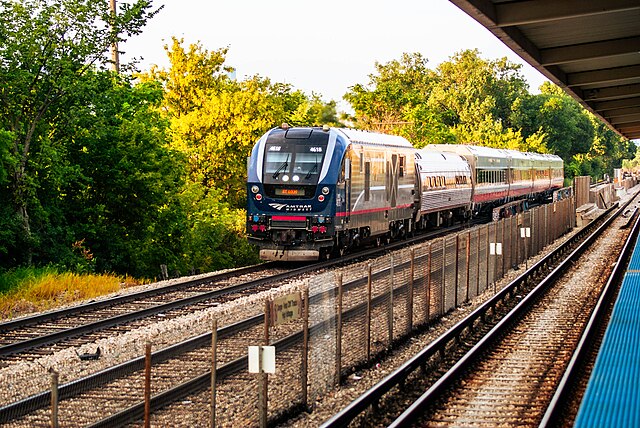“A Slow Path to Higher Speeds” fills ten pages of the September issue of Trains magazine to tell why it took Illinois 14 years to speed up passenger trains on the Chicago-St. Louis route. Originally funded by the Obama administration in 2009, the project was supposed to increase top speeds from 79 to 110 miles per hour. But top speeds aren’t average speeds, which increased only 5 miles per hour from 50 to 55. The fastest train on the timetable ended up just shy of 60 mph, a 6-mph boost over the fastest train in 2009.
Part of the cost of the Illinois project was buying new locomotives and cars. Photo by Amy Lohrke.
When Illinois received $1.14 billion in high-speed rail funds from the Obama administration in 2009, it predicted that by 2015 it would shave an hour off of Chicago-St. Louis trip times and increase frequencies from five to eight trains per day, which in turn would stimulate a 130 percent increase in ridership. But speeds and frequencies remained unchanged through early 2023. Finally, after spending $1.95 billion, speeds increased on June 26, 2023, but average trip times declined by only about a half an hour, while the number of trains per day remained unchanged at five.
Originally, 92 percent of the route was to see trains running at 110 mph. As it turned out, trains reach that speed only for a few short segments. With much lower average speeds, Illinois travelers are not impressed. Although ridership on many Amtrak routes has fully recovered from the pandemic, Chicago-St. Louis ridership in June was still 7.4 percent less than the same month in 2019.
According to the Trains article, the main problem was the federal requirement to install positive train control, without which trains are not allowed to go faster than 79 mph. Positive train control isn’t exactly a new technology, having been invented by an electrical engineer named Frank Sprague in about 1918. In 1922, the Interstate Commerce Commission ordered every major railroad in the country to install it on at least one division, which helped make possible the high-speed trains of the late 1930s. Yet in the 2010s it was still technologically unknown territory for most railroaders.
For positive train control to work, the rail system needs to know the location and speed of every train. While this seems like a job for GPS, railroaders instead tried to have trains send electronic signals through the rails. This proved to be frustrating because rails designed to support 200-ton locomotives aren’t necessarily suited to also sending signals. At one point, Illinois engineers found that the welds used to connect rails together left a magnetic residue that interfered with signals. Working out these problems is what delayed the speed-up to 2023.
With all due respect to Greg Richardson, the author of the Trains article who has worked on positive train control since 1998, the real problem is the fact that this was a government-funded project. Before he invented positive train control, Frank Sprague took just six years to develop the first workable electric streetcar system in Richmond, Virginia; the first electric rapid transit system in Chicago; and the first high-speed electric elevators in New York City. If Union Pacific thought 110-mph trains would be profitable and hired Sprague to design the system, I suspect it would have taken him a lot less than 14 years to design and install it.
Richardson agrees, blaming the delays on “the mesh of funding, operating, regulatory, and local government organizations who all have a stake and say.” He notes that “Many outside observers have opined that the benefit of the new schedules do not justify the time and cost to achieve them,” not mentioning that even after spending 60 percent more than projected the state failed to achieve most of its promised results.
However, he shrugs and says “it is a different world today” and what railroaders were able to achieve in the past “is not a relevant comparison given contemporary realities.” I would argue instead that, rather than being an excuse for spending $2 billion and 14 years to get a 5 mph improvement in speeds, such contemporary realities make the case for abolishing Amtrak and other government transportation programs that ought to be run by the private sector.









I wrote it years ago.
The ultimate problem with these transit system is the same as any other mass transit system. The people that support it wont use it themselves, the people that need it cant afford it and the people that can afford it have no use for it. It’s like rock, paper, scissors.